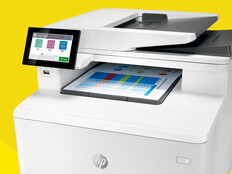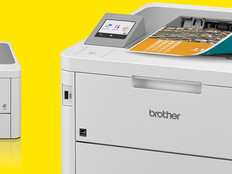The Benefits of Using Managed Print Services
The company that thinks it has squeezed every unnecessary expense out of IT operations is in for a surprise. Many might be ignoring preventable costs associated with their printing and imaging systems.
Printers, fax machines, scanners and copiers are often so far under the radar of budget hawks that some organizations don’t even have a clear idea of what they spend each year for hardware, toner, ink cartridges, paper and management overhead. The lack of oversight exists partly because the equipment is paid for from numerous budget pots — hardware capital expenses, supplies from individual departments and electricity from the facilities department. Without central control, print services costs can go undocumented, which means spending goes unmanaged.
But a growing number of IT managers have found they don’t have to live with unchecked or unnecessary printing costs. Instead, they are turning their printing environments over to specialists who offer managed print services. These turnkey approaches optimize printing resources, saving organizations money and relieving the IT department of service and support responsibilities.
Managed Print Services Benefit #1: A Range of Choices
Managed print contracts come with a wide variety of options, but most start with a service provider’s assessment of the organization’s current infrastructure to determine exactly what equipment is in place and how much it costs the business.
Sometimes this can be an eye opener. According to the tech analyst firm Gartner, organizations spend from 1 to 3 percent of their annual revenues on printing. “But when you talk about how much they spend on print, they often don’t have a clue,” says Chris Iburg, director of managed print services for Xerox. “That includes how many devices they have and how the devices are being used.”
Managed print services can be most beneficial for organizations that are highly document intensive. Law offices, for example, may see a savings of 41 percent with the right managed service, according to research firm InfoTrends, while financial firms and healthcare organizations can expect an average savings of 33 percent and 27 percent, respectively.
The savings start with right sizing — the move by service providers to turn the assessment data into an opportunity to find ways of eliminating unnecessary equipment. Managed print contracts, which typically span three to five years, also include ongoing monitoring of printing volumes so service providers can make sure devices stay stocked with toner or ink.
Service providers also perform routine maintenance on equipment and step in to fix any breakdowns that occur. In return, the user pays a set monthly fee that’s often based on a per-page rate negotiated at the start of the contract. The monthly fee covers acquisition of any new equipment, consumables and maintenance services.
Many enterprises see a number of advantages to this approach. A formal approach to managing the devices can be a catalyst for big cost savings and an increase in office efficiency, according to Bruce Dahlgren, senior vice president for managed enterprise solutions at HP’s Imaging and Printing Group. The average Fortune 1000 company can save up to 700 metric tons of paper annually and reduce energy costs by up to 40 percent, he estimates.
Managed Print Services Benefit #2: Predictable Printing
Managed print services will also make printing costs more predictable, so even if an old device needs to be replaced, the organization’s capital expense budget doesn’t take a hit.
With MPS, the enterprise consolidates its spending for consumables across the whole organization rather than losing out on volume discounts when each department buys its own supplies. Also, the organization does not spend money to keep toner or ink inventory on hand to keep machines constantly supplied with consumables.
“There are toner cartridges sitting in stockrooms,” Iburg points out. “And that inventory has costs associated with it.”
Managed print contracts can also help companies make better use of their IT staff. “Organizations are really trying to free up IT resources to drive strategic initiatives. The last thing they want to think about is managing their printers,” Iburg says. He adds that a service provider can also help the enterprise address regulatory compliance requirements for documents in specific vertical markets.
These benefits are helping the managed print model gain steam among organizations of all sizes. When the final numbers are tallied for 2011, the market in North America for managed print could hit $17.5 billion, or about 20 percent more than in 2010, according to Scott Dunham, an analyst with the Photizo Group, a research organization that tracks the industry.
He adds that the down economy in recent years may have spurred managed print services. This is especially true for larger enterprises that have looked to the solution for new ways to cut costs and consolidate IT infrastructures.
Managed Print Services Benefit #3: Hardware Consolidation
Rightsizing the print environment is a vital first step because most organizations maintain far more printers, copiers, scanners and fax machines than they need, according to Dunham. To determine the right amount of hardware, a service provider must create not only an accurate count of all relevant hardware, but it must log the age of each unit and its monthly use volumes.
In some large and midsize enterprises, the totals may average one device for every one or two employees. After an analysis by a printing technology expert, the numbers often change to a more practical ratio of one device for every six employees. “When you reduce the number of devices, you are not just saving on ink and toner, you are saving on a lot of other expenses, such as electricity bills,” Dunham says.
Print experts can reduce the hardware count without impacting productivity by finding more efficient hardware options, such as multifunction printers (MFPs), which combine a printer, copier, scanner and fax machine within a single device. Once expensive, MFPs have steadily come down in price, with many workgroup models selling for under $700.
The price becomes even more affordable because the duty cycles of these units are high enough to serve entire workgroups. This results in an overall shrinking of the hardware footprint. And the resulting cost cutting can have a ripple effect throughout a business.
Industry estimates show that for every $1 spent on printing — for toner, ink and other supplies — organizations spend another $9 to manage the printing environment. This includes the time staff spends to place purchase orders or drive to suppliers to get consumables.
Interestingly, research shows the use of tablet PCs helps to lessen print costs. Recent studies by Morgan Stanley and CompTIA indicate that the benefits that come with tablets — mobility, collaboration ease, screen resolution and size — support this trend.








